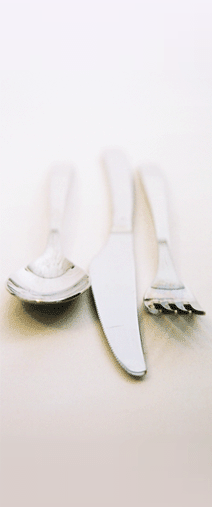The Sunday Roast
November 7, 2010
19:35 PM
I don’t know if it is being on the dry, and therefore being deprived of some of life’s little plesasures, or just the onset of some chillier weather but I seem to be looking forward to my meals with even more than my usual relish at the moment.
We are blessed with a superb butcher’s shop here in Thezan, and Michel and Natalie Butonnier who run it have become friends.
They have superb lamb which they bring down from the Aveyron (where Michel’s family came from) and hang for a decent length of time before selling on.
We have become addicted to the sweet shoulders of lamb and have gone through huge amounts during the year.
Usually I bone and stuff it , mainly for convenience of serving, but , as we are on our own , I bought one for today and had predecided that I was going to roast it with its bone in. (And this was on Saturday, thats what I mean about anticipation )
We headed off this afternoon for a stroll about the village, we wanted to have a look in the cemetery, absolutely awash with chrysanthemums since Tousaint, and then had a most pleasant wander through the now denuded, bright yellow or crimson vines.
Síle spotted a blue herb growing in the ditch and it’s aromatic smell was easily recognisable as Oregano.
Thinking of the dinner (of course) I pocketed a large bunch.
Once home I was impatient to begin.
I have great memories of The Sunday Roast in Síle’s family’s home in Skerries.
All through our courting years and long after it was a tradition.
Huge platefuls of roast beef and roast potatoes.
The potatoes were always cooked with the beef in the tin and so had a great flavour but were never truly crisp.
I had a notion of trying to fix that today.
But first the lamb.
I set the oven to 220C and let it come up to heat.
While this was happening I stripped my bunch of oregano off its stem and chopped it finely with about three fat cloves of garlic.
I added a tablespoon of lemon juice to this, a heavy handed grating of black pepper, and a good dollop of olive oil.
This mixture I now rubbed well into the shoulder of lamb, and then put it in a large roasting tin in the oven.
We have always had trouble roasting and mashing potatoes here as the French don’t go in for the floury spud like we do in Ireland.
However I have discovered that there is one good variety , the mona lisa, which our local SuperU get in from time to time.
These lads I now peeled and brought to the boil in some salted water and simmered for about 15 minutes.
At this stage the Lamb was throwing off some of its fat and sizzling nicely.
I drained off the potatoes into a sieve to make sure they were really dry.
I poured the herby, oily, fat out of the roasting tin into a strong frying pan
and then browned the par-boiled potatoes in this until they had formed a shell, then tossed them back into the roasting tin with the lamb and put this back in the oven, at the same heat for another 30 minutes.
The only other chore I had was to cook some crisp spinach which I had bought yesterday in the farmers shop.
As soon as the 30 minutes was up I gave the lamb 10 minutes to rest out of the oven covered with tinfoil.
Then I brought the shoulder to the table and carved it there.
The only accompaniment being some of the pomegranate and grape jelly I made last week (Some redcurrant would also have done nicely)
I think this was one meal that lived up to all expectations.
The meat was still pink and very moist, the potatoes crisp, herby and mildly garlicky , the jelly a delicious foil to the lamb and the spinach just absorbing all the flavours on the plate .
So what could you say, certainly not a meal that comes from any one tradition.
The lamb a la Francais with the jelly and also a la Greque with its flavours.
The potatoes was just like my mother-in-law never made them but still very much in her tradition.
The spinach, boiled in plenty of salted water and then carefully drained was exactly how I had been taught to cook it in Anjou 36 years ago.
France has the upper hand I suppose, but then it deserves it.
Welcome Lughán
November 6, 2010
14:09 PM

Born last Tuesday.
Lughán de Bhaldraithe , brother to Béibhin, son to Ronán and Sharon, first grandson to Máire and Padraic and grand nephew to Síle and me .
(He brings the total up to 44 (I think) of grand nephews/nieces)
Autumn on the Terrace
November 4, 2010
13:04 PM
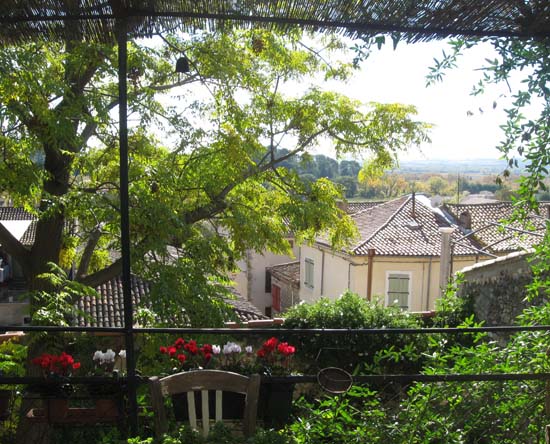
Today is a peach of a day and serves to reinforce our decision to abandon our lives in Ireland and head off to the Languedoc.
Because we had to head off for a meeting with our Accountant at 10.00 in Pezenas (about 45 minutes away) I was up reasonably early and as the sun was streaming in, took my breakfast at around 8.00 am out on the terrace.
Autumn has just started to yellow the Chinaberry Tree which dominates our back garden so when the sun came around from the East it really lit up the leaves , and then as the sun burned off the mists which had formed over the Orb Valley , the Pyrenees appeared, Mount Canigou now capped with snow and then all the range as far as I can see.
I must at least be able to see Pic de Jer, the mountain over Lourdes, which must be a full 300 kilometres away.
For November it is a very warm day here, the temperatures in the early 20’s.
We had to have the air-conditioning on in the car all the way home from Pezenas.
We are having a full week off between clients at the moment so are getting a lot of extra work done but today, after the accountant, is free.
C’est la vie.
Dry November
November 3, 2010
17:53 PM
(With apologies to Thomas Hood)
No Beer, No Wine
No Downs’s Number Nine
No Fino, Manzanilla, Noilly Prat
No Gin, No Port, No Picpoul de Pinet
No easing of the pain in any member
No Macon Lugny No! nor Chardonnay.
No Burgundy
No Cotes du Rhone
November
If Winter Comes……..
November 3, 2010
14:50 PM
Well we must be prepared for the worst mustn’t we.
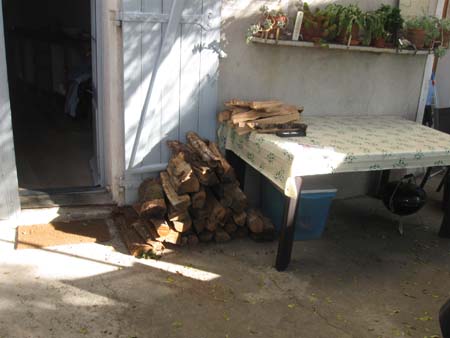
And this is all we have left of last years wood.
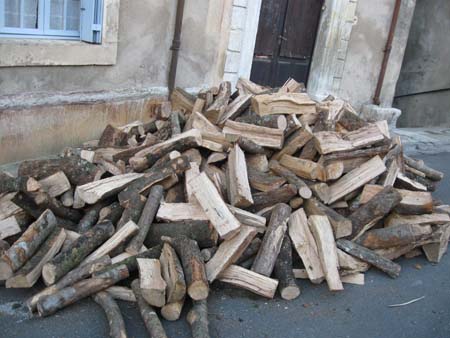
This morning at 8 am, this little load, four steres ( a stere is a cubic metre ) of Oak and Beech, were deposited outside our front door.
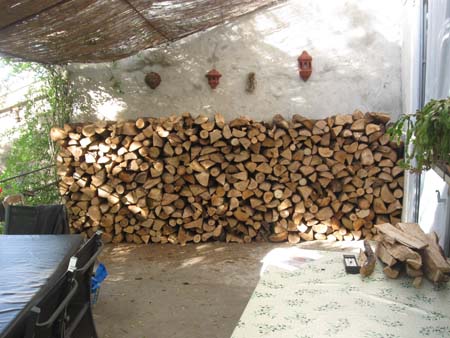
Two hours later this hugely satisfying pile was neatly, nay beautifully , arranged on our terrace.
(ie : two hours and two knackered Dwyers later)
I must confess I gazed in wonder and satisfaction at the pile for some minutes, some primitive instinct overtook me , a feeling that I had provided for my family against the winter .
(Funnily I can never remember feeling the same, or gazing with the same rapture at the full tank of oil in Waterford)
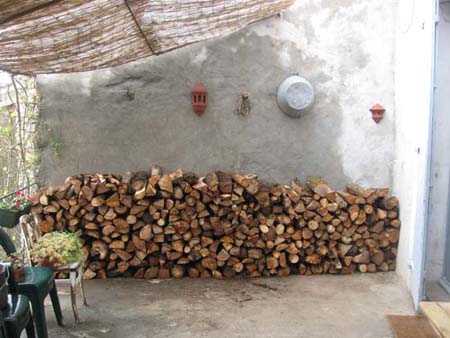
As I said we got four steres this year compared to three last year (pictured freshly delivered above)
I think we did better this year, so either he gave us a bit extra this year to thank us for our custom, or, he did us, last year.
Being naturally charitable I go for the former.
3 comments
Pomegranate and Grape Jelly
November 2, 2010
19:48 PM
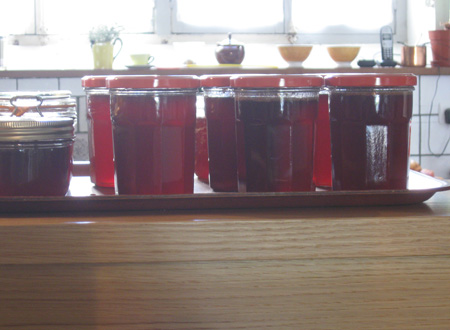
This is I would say my last jelly or jam of the Autumn and I have made it this year later than most.
This is another one which I pinch from the hedgerows and would qualify (if sugar were free ) as A Food for Free.
Mind you it is not all pinched from the hergerows, the grapes are pinched from the vineyards- but not until abandonned by the winemaker.
Nowadays the vast majority of wine here is made from grapes which have been picked by machine.
This is done by a strange tall contraption which hoovers the grapes off their stems.
However clever it is it always leaves a few grapes after it.
If the farmer hasn’t sent out some workers to the fields to glean these within a few weeks (and they never do ) I reckon they are mine for the picking.
These I put through my faithful Mouli Legume (see previous entry) which neatly separates the juice from the seeds and skins.
I tried making a little pot of jelly from this juice but it was a bit characterless and sweet.
At the same time as I was gleaning the vinyards last year the pomegranates were reddening nicely on the hedgerows.
With these I discovered that my orange juicer (a sort of huge garlic squeezer on feet) did a superb job of juice extraction.
Jelly made from this was a little caustic for spreading on croissants.
Fifty fifty worked a treat last year , just the right blend of acidity and sugar.
This year I decided to do the same but, unfortunately the Pomegranates were slow this year so I froze my Grape Juice awaiting their partners.
This happened last week.
I mixed the juices half and half.
I had a litre of each.
In a large pot I mixed these with two kilos of special jam sugar and then heated this gently until the sugar was completely melted.
Then I divided this between two pots, put it on the heat and brought it to a rolling boil.
I boiled it for five minutes, as they said on the packet, then tested it for setting on a cold saucer-no set.
This was unusual but maybe one or other of the fruits are low in pectin.
Anyway I gave both pots another five minutes of vigorous boiling and they both showed signs of setting then.
For those not in the know I have ready a saucer, cold in the fridge.
To test for setting I put a small tablespoon on the saucer, put it back in the fridge, then after a couple of minutes I take it out.
If pushed with my finger it then should wrinkle up.
The second time I got the desired reaction so I potted the lot.
I got nine jars of a little less that a half kilo.
So that is it and the store cupboard is now nicely full of jams and jellies.
2 comments
Le Mouli Legumes
November 2, 2010
18:24 PM
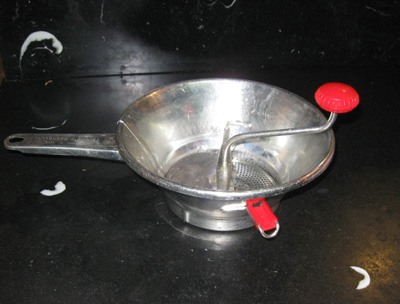
Since I burned out the engine of my Liquidiser a couple of weeks ago I have reverted to using my old Mouli Legumes, and I will tell you something it is a terrific machine and I am not at all sure that it is a disimprovement.
In many ways it is a better machine.
Take Jerusalem Artichoke Soup, probably the best soup of all.
Normal starting point, first peel the artichokes, not necessary with the Mouli, instead you give them a good hard wash (a scrub even if you are fussy).
Then sweat some peeled and sliced onions in butter , slice the unpeeled artichokes, add to the pan, continue to sweat with the onions until soft, add some chicken stock.
Boil up, pass through the finest blade of the mouli, it will delicately hold back just the artichoke skins, leaving you with a smooth velvet puree, without all the fiddle of peeling these impossibly knobbley monsters.
It does the same job on quinces to make the Dulce de Membrillo, see last weeks recipe, it makes an immaculate job of skinning and de-pipping some tomatoes, first softened in oil , and turns them into a smooth puree.
Use it for making apple sauce for pork, without peeling and coring, it will destring sautied chicken livers to make a smooth pate,if you put cooked chick peas through the coarse blade they make the best, authentic, slightly rough, crunchy, hummous.
But the job for which it is invaluable and for which it has no peer, and the reason why we always had a large one in Dwyers Restaurant is the making of Mashed Potatoes.
It matters not whether you like a smooth creamy mash or a light floury fluffy one the sine qua non of all mashed potatoes is that it should be lump free, (lumpy mash makes me gag)
To achieve this you must steam your potatoes until very tender, then push them through a potato ricer- very hard work, or, even more laborously, push them through a sieve or, take the easy path and pass them in seconds through a Mouli Legume.
It is worth having one in the kitchen for that job alone.
And how much does it cost for this beauty, which surpasses a food processor or liquidiser in skills ?
About €18, available in any supermarket in France and any kitchen equipment shop in Ireland.
1 comment.
Spanish Icons
October 30, 2010
14:56 PM
Before I leave Spain behind I want to put up some pictures of the fascinating and highly charged images they used to decorate their churches.

This writhing martyr in Cadiz Cathedral was not Sebastian but (I think ) Damian.
An image like this would be far too dramatic (and erotic?) to be shown in an Irish church.

This Ecce Homo image of Christ in Sanlucar was the way he was most frequently shown, halfway through his torment , being displayed to the mob.

This time it is St Sebastian being martyred , also in Cadiz with a far bloodier Ecce Homo in front of him

In Sanlucar they also provided a huge picture of my patron; St Roch. Apologies for the quality but it was my best shot.

This was the most shocking of all the images, a statue of the crucified Baby Jesus, the stuff of nightmares.
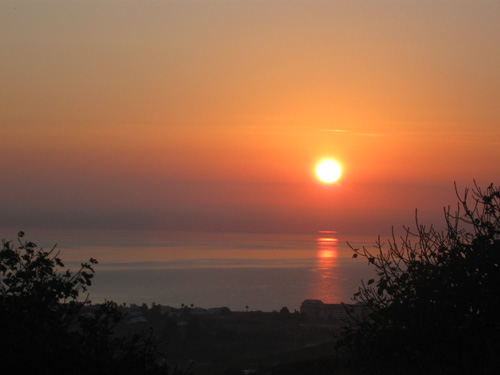
No saints or martyrs in this shot, just the sun rising over Manilva taken from the front of Michael’s house the morning we left.
A great holiday.
2 comments
Liqueurs
October 29, 2010
14:43 PM
Ever since reading Jane Grigson’s Good Things in 1975 I have been fascinated with making my own Ratafias and Fruit Liqueurs.
Over the years I have had a certain mixed success but all have been drunk to the end, even those which my nearest and dearest have described as being like Cough Syrup.
Without doubt the most popular was the Sloe Gin, which I have taken to making with other spirits other than Gin with no lack of quality.
This was my house liqueur in Dwyers Restaurant and I used to make up, and sell, several gallons a year.
A kindly Kilkenny farmers wife used to pick kilos of sloes for me every autumn which I would buy from her, freeze, and make up into the liqueur gradually over the year. (the secret of making it successfully is to wait for the first frost to soften the skins, or, freeze the fruit before making it)
When the restaurant closed I was left with about 6 kilos of sloes in the freezer and, as there was no way I was going to discard such treasures, I brought them, still frozen, to France with me.
About six months ago I macerated the first three kilos in alcohol and today, being an otherwise free day, I thought it would be a good moment to proceed with the bottling.
As well as the Sloes I had, on the top of my kitchen cupboard macerating gently in alcohol three other fruits put there last summer, that is the summer of ’09 and now also ready for bottling.
My method of making these liqueurs doesn’t vary much.
I strain then off their fruit, sweeten or flavour to taste, and then seal in bottles until called upon to offer a sample.
Because I like to offer my guests a digistif after their dinner we do seem to go through quite a lot.
But back to the manufacture.
I have found over the years that despite precise instructions of amounts of sugar to be added during the maceration stage that it is much better to sweeten after this stage, to taste, just before bottling.
With four mixtures to taste, adjust, and then taste again, and again, this turned out to be quite a fun occupation, almost merrymaking, for a cloudy day.
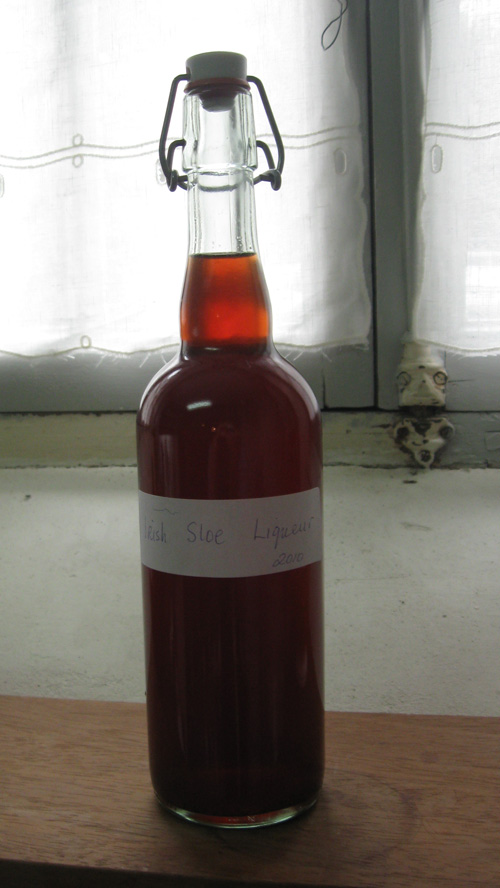
My Sloe Liqueur was the least troublesome.
A little sugar syrup and it was ready to be bottled, all four litres of it.
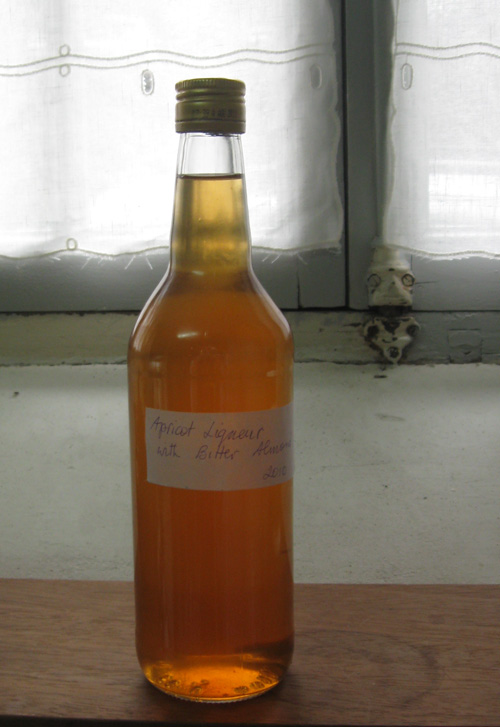
The Apricot was a bit of a disappointment, it needed a lot of sweetning to bring out the flavour but then I had to add a bitter almond to each bottle to make sure it didnt taste too bland.
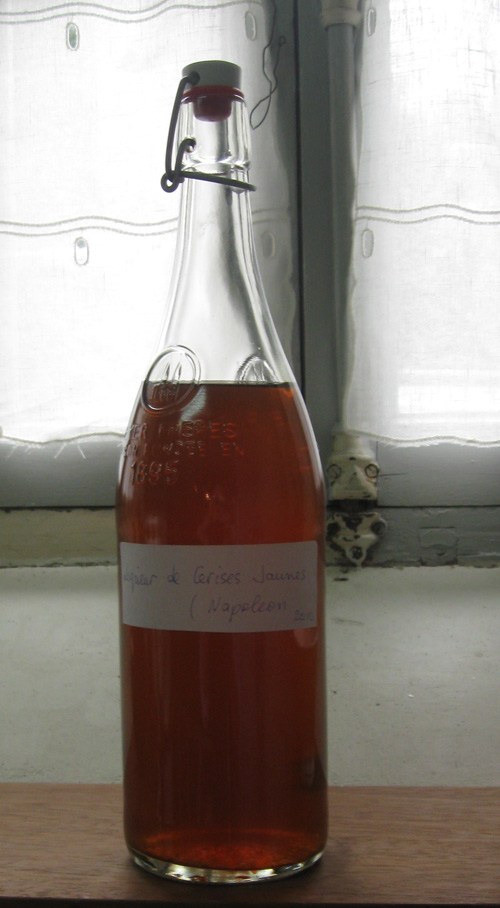
The Napoleon Cherry I have already tasted and it is excellent, a little extra sweetness to bolster it’s already high sugar level and it is ready for consumption.
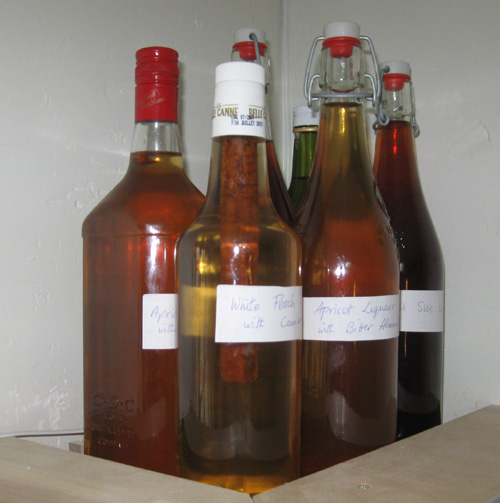
The White Peach, my very favourite fruit, was the bigest disappointment at first sip.
There was the faintest flavour of its delicious floral essence which some lemon juice and lots of sugar helped to come through but I still felt it needed some help and a cinnamon stick in each bottle seemed like a good idea at the time.
At this stage with the best part of a dozen litres of Liqueur on the shelves there was a feeling, expressed by the female half of the business, that I wouldn’t need any more for another ten years or so.
Fear not.
I have a little nest egg or three down against the future.
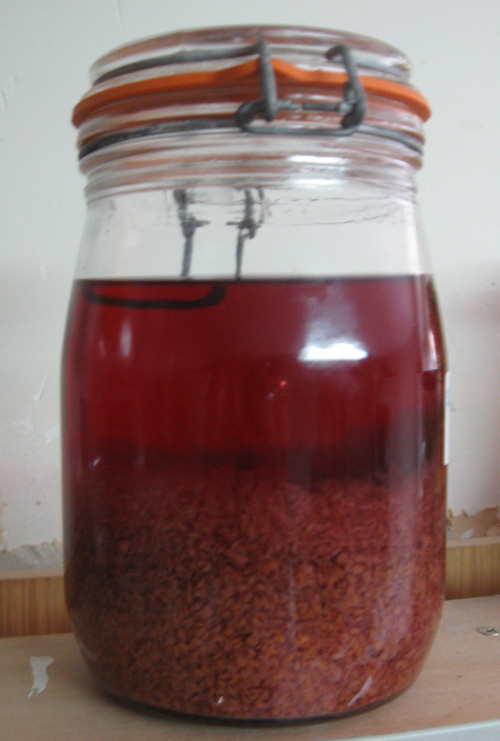
A jar of my trail blazing Raspberry Pip Liqueur
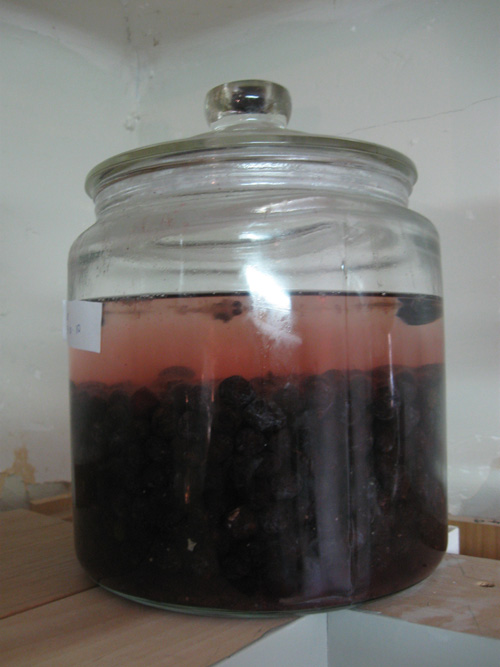
Two litres odd made with the last of the Irish Sloes
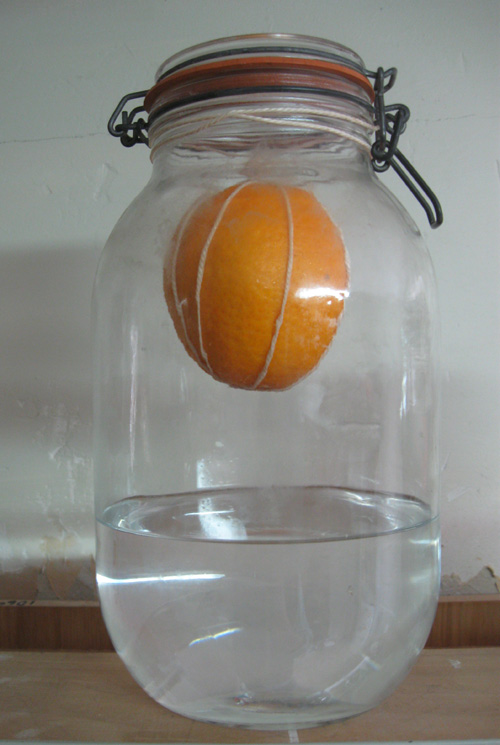
And a litre of my Orange Liqueur.
Believe it or not at the end of six months the orange will be a pale anaemic version of its former self and the spirits below will have a warm orange tinge.
I am told this is the way the Cointreau family make their famous liqueur.
All this on the cusp of November when I forswear the demon drink for a month.
I don’t know at all at all.
2 comments
International Statistics
October 29, 2010
08:45 AM
Now that my new website on Le Presbytere ; www.lepresbytere.net is now fully up and running in two languages it is interesting to see who is reading it.
Not of course that I know the persons name, just the country they are coming from.
As I would expect the majority, nearly, come from Ireland, coming in at just under 50%- way lower than my Blog whose readership is about 70% Irish.
Coming next is France at 30%, this is a healthy sign as I certainly am going to need more French customers to survive.
Then in more or less descending order come nibbles from the UK , Belgium , the US , Spain, Holland and Germany, all countries within about a 12 hour drive (except of course the US of A) All these I would have thought part of my customer base.
Then come the longer shots, Argentina , Norway , Austria , Australia , India , Saudi , Morocco , Denmark and lastly Italy with just a single nibble (well they do have their own tourismo).
Nary a sign from Sweden who love to travel to the south or from Finland who would have even further to go.
It will be interesting to see if any of these nibbles become bookings.
|
